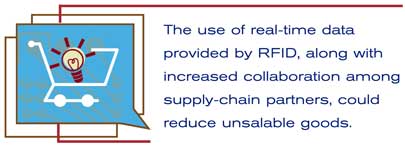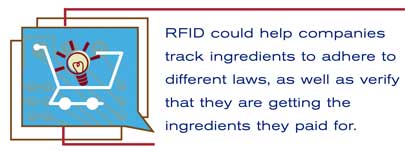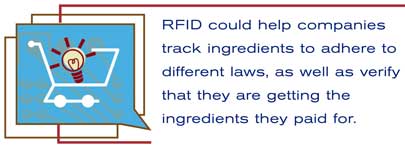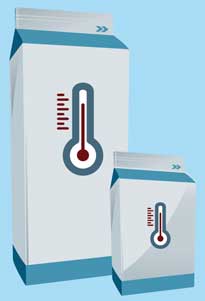Many large packaged-food manufacturers are in the same boat as Nestlé. The Swiss-based international producer of chocolate, baby food, pet food and other food products has been RFID-tagging cases and pallets of goods to meet retailer mandates from Wal-Mart in the United States, Tesco in the United Kingdom and Metro Group in Germany. The retailers are using RFID data to reduce out-of-stocks, automate receipt of goods and keep better tabs on inventory. But Nestlé believed the benefits were somewhat one-sided, because the company had already optimized its internal business processes with information technology.
At least, that’s what Nestlé officials thought until researchers at Cambridge University’s Institute for Manufacturing convinced the company to re-examine its internal production processes in the making of everything from chocolate to coffee. Nestlé U.K. has since identified a handful of business benefits that it could gain from using RFID, in preparation for RFID pilots that could begin early next year in conjunction with the European Union-funded BRIDGE project, coordinated by GS1.
|
|
Among the potential pilots is a track-and-trace operation to RFID-tag reusable containers employed in the manufacturing process, including vessels that transport ingredients, bins that hold chocolate candies waiting to be packaged and molds used to make the candies. “We need to know where they are and what state they’re in—are they available, have they been cleaned, are they full or empty, and what product was made in them last,” says Paul Roberts, logistics manager of Nestlé U.K., who is shepherding the BRIDGE pilots.
Another potential pilot would track chocolates with filled centers as they come off the production line and are temporarily stored until they are packed with other assorted chocolates. The bins would be RFID-tagged, and the products inside would be associated with that tag in a database, Roberts says. Nestlé already has some software that uses bar codes to track the bins, but “that still requires human intervention,” he says. The company would like to automate that tracking process with RFID.
As more retailers issue RFID-tagging mandates—Sam’s Club, the warehouse retail chain owned and operated by Wal-Mart, recently upped the ante by requiring that suppliers tag all “sellable units” by October 2010—both large and small packaged-food manufacturers will need to look for internal and supply-chain benefits to offset the costs. For large companies like Nestlé that have optimized their businesses processes, RFID can enable improvements and automation that other IT hardware and software products cannot. Smaller manufacturers that haven’t already gained efficiencies in their business operations with the use of IT stand to gain even more benefits.
“Manufacturers have for many years invested in automation and trimmed processes down to the point where they’re lean in operation,” Roberts says. “At the end of the day, the only driver that’s going to get RFID adopted is if business benefits are involved.” Nestlé’s interest in testing RFID internally was “driven by the recognition that there were probably areas in our business capable of generating savings,” he says.
Those business benefits extend to the supply chain. Some consumer packaged-goods companies that have been RFID-tagging goods for Wal-Mart have been using the data the retailer makes available to reduce out-of-stocks, better manage new-product introductions, reduce chargebacks, improve order reconciliation and minimize shrinkage. For packaged-food manufacturers, RFID enables other benefits, such as reducing loss from out-of-date goods, identifying items for recalls, and meeting government regulations to improve the safety and traceability of food products.
Even manufacturers that aren’t under retailer mandates are discovering benefits from RFID-tagging products. In particular, companies are combining RFID tags with sensors to monitor perishable foods.
Rescuing Unsalables
Every year, according to the Grocery Manufacturers of America, more than 1 percent of food, beverage and other consumer products have to be thrown away because they are unable to be sold. The trade group defines “unsalables” as goods that are damaged, out of date or seasonal. Combined, they cost industry more than $2 billion per year—and manufacturers have to absorb much of that, because they often reimburse supermarkets and other stores for unsalable goods. Some packaged-food manufacturers believe the use of real-time data provided by RFID, along with increased collaboration among supply-chain partners, could reduce unsalable goods, or shrinkage.
“Right now, when retailers get products in that are bar-coded, they may get 50 cases of, say, bagged salads today, and 50 cases of bagged salads tomorrow; they all have the same bar codes on them, and now they have 100 cases of bagged salads,” says Bill Hardgrave, director of the University of Arkansas’ RFID Research Center. “If the retailer is not diligent in making sure that the first ones that came in are the first to go out on the floor, you may end up with the freshest product out on the floor first, instead of the product that was the first to come in.”
Wal-Mart and some packaged-food manufacturers that have met the retailer’s tagging mandate are using RFID data to determine which product was “first in” so that it could be the “first out” to the floor. RFID tags are read when products leave the manufacturer, when they arrive at a distribution center, when they arrive at the back room of a retail store and before they go out to the floor.
“If the sharing is in both directions [between supplier and retailer],” Hardgrave says, “the supplier could say, ‘Now we see why there is a quality issue, or why the sales are not too good—it’s because the freshest product is not being rotated properly.'” The data is there, Hardgrave says, and once more retailers and suppliers start sharing that data, consumers will benefit from fresher products and lower prices because of less shrinkage.
Product rotation isn’t just an issue with fresh packaged foods. Many food products have expiration dates, and if they sit in storerooms or DCs, the items may become unsalable. Even if products don’t have expiration dates, they could become outdated if a manufacturer introduces an improved product or new packaging. Retailers may have to cut costs to get rid of the older product, which is a form of shrinkage, Hardgrave says.
Earlier this year, Compañía de Galletas Noel, a Colombian manufacturer of cookies and crackers, successfully completed a two-year RFID pilot with Almacenes Exito, Colombia’s largest retailer, which showed that RFID technology could help improve order fulfillment, given that its products have a limited shelf life of six months or so. Now Compañía de Galletas Noel and Almacenes Exito are expanding the pilot to tackle out-of-stocks, so that goods are on store shelves when consumers want to buy them. Currently, Almacenes Exito is retooling its information systems so point-of-sale data will be available electronically in the Electronic Product Code Information Services (EPCIS) database.
“With that information, [the retailer] can calculate the possible out-of-stocks on the sales floor,” says Leonardo Vitolo, logistics director of LOGyCA Consulting Services, which is coordinating the pilot. “Initially, it’s going to be used by the retailer’s staff to find goods when inventory is available in the back room that needs to be put onto store shelves.”
But the potential exists for using the data to move inventory between stores, depending on need, and also to send alerts to the manufacturer asking for replenishment of stock if inventory gets too low. “If there is an SKU [stock-keeping unit] that reaches a minimum inventory level, there is a tool to send an e-mail to both the retailer and manufacturer advising them that they need more inventory of that SKU,” Vitolo says.
RFID Lifelines
It seems that barely a month goes by in which government authorities don’t issue recalls for food products that have sickened consumers, or worse. Recalls can be vast and costly if a manufacturer can’t identify the lot and batches suspected of being tainted.
Some food companies are turning to RFID in the hope that should a recall be necessary, the technology could pinpoint the contaminated lots. After having to recall all of its packaged spinach following an E. coli outbreak in 2006 that sickened 200 people, Dole Foods started tracking vegetables as they were harvested from the field, through processing and packaging, and on to retail stores, using RFID-enabled pallets from Orlando, Fla.-based Intelligent Global Pooling Systems (iGPS). In June, iGPS announced that the tests were complete and Dole would start expanding its use of the RFID-enabled pallets.
“They know they can track and trace what field, and what row within a field, the product was picked from,” says Jack Sparn, chief information officer for iGPS. “They track it beginning with the harvest, all the way to the end at the store. There’s traceability, should there be a recall.”
Many recalled products are fresh meats or produce, but increasingly, packaged foods that contain a contaminated ingredient need to be identified and recalled. In September, the U.S. Food and Drug Administration issued an alert regarding infant formula from China that contained high levels of melamine—the same substance found in pet foods in 2007 that resulted in illness and death in thousands of cats and dogs. The contaminated formula sickened more than 50 children in China. The FDA said that no infant formula from China had been approved for import, but cautioned that some might be available in ethnic grocery stores.
“RFID helps establish the source of origin for all the ingredients,” says Himanshu Bhatt, who leads the supply-chain and logistics solution program for IBM Global Solutions. “So in case of safety recalls, it’s possible to backtrack and see where things have come from.”
Some global food companies need to track ingredients to adhere to different laws in different regions of the world. Genetically modified food products, for example, cannot be sold in the European Union, and to protect consumers, EU food laws require transparency concerning traceability and labeling. Packaged-food companies that use corn, soybean or other products that have been grown from genetically modified seeds need to separate those supplies to ensure they aren’t shipped to Europe. RFID tracking of raw ingredients by food companies would be one way to ensure the separation of genetically modified products, says David Closs, a professor of supply-chain management at Michigan State University.
RFID also could help companies verify that they are getting the ingredients they paid for. A cereal maker that imports freeze-dried strawberries, for example, could ask that RFID be used to track and trace the fruit back to the farm, to prove that it was grown in Korea instead of China, where rules about use of pesticides may be less stringent.
As the food industry becomes more global, governments are demanding that suppliers provide better traceability of imported products to protect consumers from potential hazards such as bioterrorism or the spread of dangerous pathogens like E. coli. The FDA, acting under the Public Health Security and Bioterrorism Preparedness and Response Act of 2002, developed new food requirements that went into effect in 2004 regarding traceability of food supplies and imports. In 2007, the FDA developed the Food Protection Plan, which gives the agency authority to demand electronic notices of imports from high-risk countries, refuse imports and get access to food records during emergencies. The FDA began holding hearings in October to seek better ways to track fresh produce, with RFID being one of the potential solutions.
There also are stringent regional laws regarding cleanliness of reusable assets in the food industry, such as plastic trays, containers, molds and totes. “You have to demonstrate that you’re cleaning the equipment correctly when handling food products,” says Ashley Stephenson, chairman of Reva Systems, a Chelmsford, Mass.-based RFID provider. RFID-tagging the reusable assets and rigging up readers at the washing station “can help you automate monitoring of that, allowing you to produce reports saying that everything has been through the sterilizer and washer,” Stephenson says.
Nestlé is interested in RFID-tracking its chocolate molds, Roberts says, because repeated washings can degrade the plastic. If a mold cracks during production, pieces of plastic could break off and the entire batch of chocolate would need to be discarded. If Nestlé could determine how many washings a mold could withstand before breaking and track that information, it could take older molds out of circulation before any accidents occurred.
Sink or Float
Compliance with retailer tagging mandates is still the key driver for adoption of RFID in the packaged-foods industry, says Henri Barthel, director of global partnerships and projects for GS1 and director of the BRIDGE project. The question remains: Will suppliers accept slap-and-ship tagging as the cost of doing business, or will they integrate RFID tagging with their back-end systems so they can achieve internal and supply-chain benefits?
Barthel believes suppliers can realize a return on investment by using RFID in the food production process to provide traceability of different ingredients used to make finished products. “This has a huge potential in terms of food manufacturing,” he says, “and could trigger more interest in RFID.”
And Hardgrave’s research indicates that food companies can achieve benefits from tracking cases and pallets in the supply chain. In the future, he says, item-level tagging of packaged foods will allow manufacturers to “drill down into that next layer. It really gives you a real-time view of what’s selling, all the way down to the unit level.” But there’s a big difference in ROI between tagging a six-pack of canned soup for a warehouse store such as Sam’s Club and tagging a single can sold in a retail store. This likely indicates that item-level tagging will at least start with more valuable food products, rather than for all products at the same time.
It’s particularly challenging to convince food manufacturers to invest in RFID during a global economic crisis. BRIDGE is currently trying to recruit food companies to join forces with GS1 and test the use of the technology in the food manufacturing process. Benedicta, a small, independent maker of mayonnaise in France, has signed on because it sees RFID as a way to leverage efficiencies and survive competing against much larger companies.
Still, keeping food safe in a global market could become the key driver of RFID adoption. As the international supply chain becomes more complex, it will be critical for companies to ensure the safety of ingredients, protect their brands from counterfeiting and identify the source of products in case of recalls. “We’re getting a lot of experience in pharma, and that will translate into food when the economics are right,” says Michigan State’s Closs. “It’s giving us a lot of experience and knowledge of international movements of goods and counterfeiting.”
Barthel agrees. “Food products are very complex, even more complex than electronics or televisions, in that you need 100 percent insurance that what you’re doing is safe for the consumer,” Barthel says. “This is critical for this type of industry.”
Benefit-Driven Adoption
Smith Brothers Farms, a dairy business founded in 1920 in Kent, Wash., is a throwback to the old days because it still offers home delivery of fresh milk. But when it comes to using technology, the company is surprisingly 21st-century. Smith Brothers uses RFID tags with temperature sensors to optimize the shelf life of its milks and keep customers happy.
Smith Brothers, which prides itself on selling milk products from local cows raised without artificial growth hormones, wasn’t under a retailer tagging mandate when it adopted RFID more than a year ago. The company uses semi-active TurboTags from Sealed Air to monitor and record milk temperatures from the processing plant, through transit and up to the point of delivery. Temperature monitoring helps Smith Brothers minimize waste by ensuring that milk is kept at optimal temperatures.
“It’s critical in the milk industry to keep milk below 40 degrees, because you have a shelf life for your milk,” says Gary Waldie, plant manager for Smith Brothers. “Anytime that milk gets above 42 degrees, you’re basically asking for trouble.” That’s because bacteria breeds at higher temperatures.
Temperature sensors combined with RFID tags provide real-time information on products in the cold chain, delivering value to manufacturers and retailers that could help drive adoption in the food industry. Earlier this year, Manor, Switzerland’s largest retail chain, began using active RFID tags with built-in sensors to measure and log temperatures in the chain’s 1,800 freezers and refrigerators every 10 minutes, even when the stores are closed. The Italian arm of Nestlé also has been piloting the use of battery-powered RFID tags in conjunction with sensors to track ice cream as it moves from production factories to distribution centers and then to retail stores.
“It’s a matter of controlling your quality of product and assessing if there is a weak link in the supply chain,” says Jean-Pierre Emond, co-director of the IFAS Center for Food Distribution and Retailing at the University of Florida, who has been studying the use of sensors in the food industry. RFID tags with humidity and ethylene sensors (to detect produce spoilage) are being developed for the food industry.
Motorola has identified cold-chain sensors as a potential growth area, particularly for the perishable-food market, and is looking to develop low-cost sensors, according to Tom Reese, Motorola’s senior manager for business development. In addition, the company is developing software applications to go along with the hardware solution to “help customers make sense of the data and act on it,” Reese says. “This would not require them to have the knowledge of the science to interpret the data.” Employing shelf-life prediction models, IT staff could read the sensor data and use computer algorithms to come up with appropriate shelf-life dates for the products.





